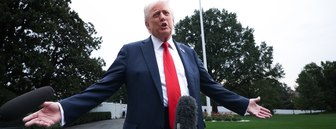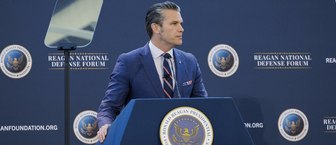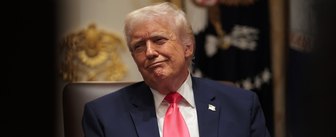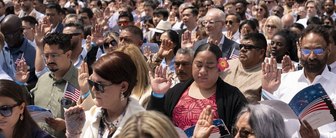Public opinion surveys about the coronavirus have produced consistently partisan findings. In poll after poll, Republicans and supporters of President Donald Trump express less concern than Democrats and more skepticism about the severity of the virus.
But when it comes to tangible actions, the partisanship seems to fade.
Consider the data. The most recent Yahoo News/YouGov survey shows four out of five Americans (79%) are worried about the virus, with concern significantly higher among Democrats (88%) than Republicans (70%).
The spread of the COVID–19 virus so far has been far greater in a few urban and heavily Democratic areas of the United States, giving rise to speculation about geographic realities impacting how red and blue America are experiencing the pandemic. The Yahoo/YouGov tracking shows some urban-rural differences, but the similarities across regions are more striking.
Specifically, when it comes to worries about coronavirus, a partisan divide persists in both cities (87% worried among Democrats vs 75% among Republicans) and suburbs (89% vs 73%), with areas identified by respondent self reports. The worry gap is wider among respondents who say they live in towns and rural areas (89% vs 65%), mostly because worries are lower among Republicans.
The gaps have been bigger – in urban, suburban and rural areas – for belief that the threat of coronavirus has been overstated. One in 10 Democrats considers the threat exaggerated, with little urban-rural difference, while better than a third of Republicans, including nearly half in rural areas, expresses similar skepticism.
But the partisanship fades when it comes to taking tangible actions. Overwhelming majorities of both Democrats and Republicans report they are heeding calls to stay home and take recommended precautions, according to the Yahoo News/YouGov survey. For example, 72 percent of all Americans said they were avoiding crowded places on the most recent Yahoo/YouGov tracker, up sharply from 37 percent in early March.
The partisan gaps remain modest on the question of social distancing, differing by just single digits in suburbs and rural areas. In presumably more crowded urban areas, reports of avoiding crowds are lower overall and the partisan gap is slightly greater.
The findings are similar for those who report they “stopped leaving the house except for essential activities” (a question asked on the last two surveys only). Once again, an overwhelming majority (70% overall) say they are staying home, with insignificant differences across cities, suburbs and rural areas and modest, single-digit gaps between Democrats and Republicans.
In fact, the patterns are similar for various other social distancing measures tested on the Yahoo/YouGov tracking surveys. For the last two surveys, we asked about eight specific measures that have been recommended or in some cases, legally mandated, by federal and state governments: avoiding crowded places, staying home except for essential activities, staying six feet away from others, washing hands more often, buying hand sanitizer, wearing a face mask and stopping hand-shaking and eating at restaurants. In late March, on average, our respondents reported making 4.4 of these possible eight changes to their routine. By April 6–7, that number rose to an average of 4.9.
But among the subgroups, the average number of social distancing changes reported by each respondent showed only a slight partisan gap and little variation across the urban-rural divide. In urban and suburban areas, the partisan gap narrowed slightly in early April. A slightly greater partisan difference persisted in rural areas, but it still amounted to less than one social distancing measure reported, on average, by Republicans than by Democrats.
So while America’s endemic political polarization drives big differences in worries about coronavirus and perceptions that its severity has been exaggerated, most Americans have put aside their skepticism and have been practicing social distancing.
Looking at the data another way, even among Americans who believe the threat of coronavirus has been exaggerated, roughly half now report they are avoiding crowded public places (52%), staying at home except for essential activities (49%), washing their hands more frequently (55%) and staying six feet away from other people in public places (56%).
The survey findings are based on self-reports of social distancing, and actual behavior may differ. Published reports on behavioral data have been mixed, so far, in terms of urban-rural patterns. Anonymous cellphone data analyzed by The New York Times show Americans in many rural areas, especially in states that waited longer to enact stay-at-home orders, continuing normal travel patterns while those in other areas significantly reduced their travel distances. On the other hand, data from OpenTable shows similar declines in restaurant attendance in all fifty states, and reports from regional energy providers show large declines in electricity use across – reflecting an overall economic slowdown – in both cities and rural areas.
Nonetheless, the survey data adds to the evidence that social distancing is working. The findings help confirm that Americans are practicing the social distancing measures and thus helping to slow the spread of the coronavirus and its projected death rate.
At the heart of this progress is what The Atlantic’s Ed Yong calls our nation’s “single most effective weapon against the pandemic — the willingness of its citizens to make individual sacrifices for the sake of all.”
Our survey data shows this spirit of self-sacrifice at work. In the coming weeks and months, government decision-makers will need to decide how far that spirit can be pushed.
Methodology: The Yahoo! News survey was conducted by YouGov using a nationally representative sample of 1,566 US adult residents interviewed online between April 6-7, 2020. This sample was weighted according to gender, age, race, and education. Respondents were selected from YouGov’s opt-in panel to be representative of all U.S residents. The margin of error is approximately 3.4 percent.
Image: Getty












